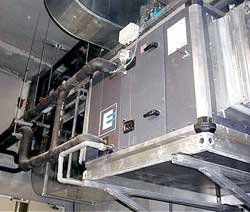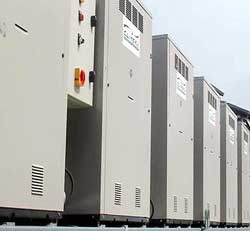






 |
Musée de la Vallée du LotDehumidification, humidification, Programmist architect: GYP Consultants The Museum of the Lot Valley extension project takes place in an architectural reflection combining the wills of preserving the heritage and opening to the XXI century. Indeed, the museum is located in a gorgeous building of which basements are immersed in the Lot river. For these new buildings, a successful energetical concept, economic and able to manage both temperatures and air handling had to be found. EcoEnergie’s solution has seemed to us the more complete as far as it has shown the advantage to suggest an homogeneous set of « machines » and « controls ».This choice has been vividly approved by the Museums of France Management coextensive with the French Arts Ministry, and especially by the technical departments who have been attracted by the concept, the performances (hot and cold outputs cut down of 40%) and the specific humidity control. The communicating technology assures the costumers of following temperatures, orders and consumption. The operating and parametring flexibility allows the customers an operating freedom while respecting the basic technical orders. The excellent partnership between the conceptor, the industrial and the installer leads to the satisfaction of the costumer with a discreet, functional, economical and modern installation.This modernity takes place in the original project of architectural innovation. The choice concerning the cooling technical solution results of various considered factors, that is to say, energy, savings, environment and innovation.
Natural gas is a complete answer to these various criterions: absorption cold production by a water/ ammonia solution. Cold is obtained by a chemical reaction resulting from the heating of the solution, from which ammonia evaporates before passing through two exchangers, afterwards it goes into the absorber, in which ammonia rejoins the liquid water. That is the reason why it is called the absorption system. This equipment of six instead of ten modules assembled in succession permits a constant cold production perfectly sized to the specific needs. |


The cooling system is free from any CFC or HCFC fluid and respects the environment. Moreover, the machine is noiseless and could be set up hence outside and near dwellings.
A box fitted with a set of coils, the circuiting of which are specific, assures of dehumidification and cooling. The chilled water supplied at + 5°C by the ducts feed up the box.

EcoMusée
A spraying humidifier allows to increase the specific humidity.
The heating coil allows to rebalance the thermal losses and to heat the loaded air.
The air is diffused by units fitted with air extracting and discharging motors as well as a range of equipment as filters, dampers, cool and hot coil, attenuators and control sensors.
Located in technical premises, these units handle museum air via air ducts that end with linear air discharging or returning grids, integrated to the walls or ceilings.
Those grids, commonly called ribbons, run on the entire length of the room. Thin and discreet, the grids assure of a perfect homogeneousness of the air flow, and at a low speed, thanks to the disposition on the entire length of the grids of the air discharging and returning.
Name of the signatory:
François Peraire, thermal engineer.
